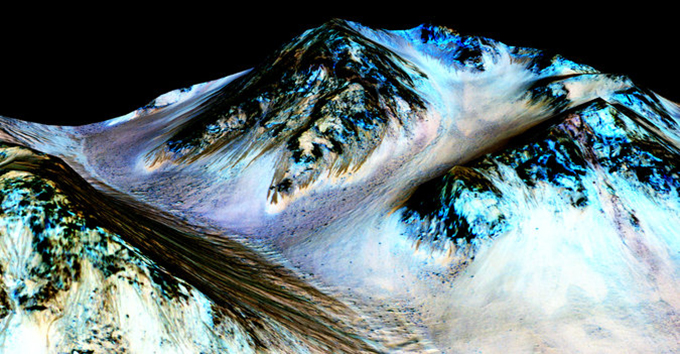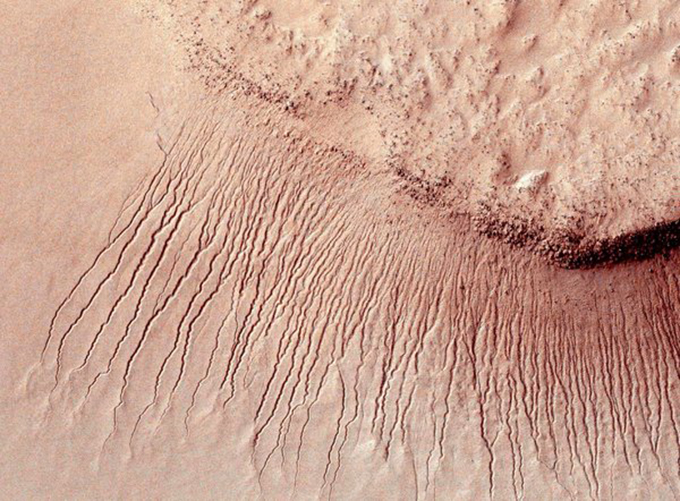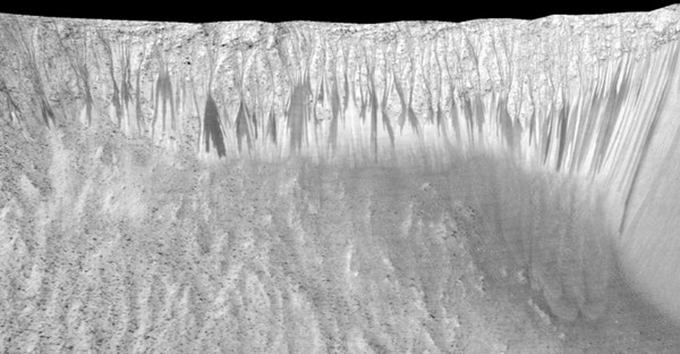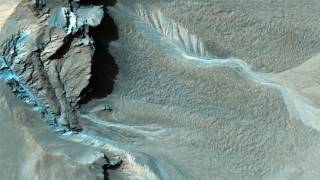NASA Confirms Signs of Water Flowing on Mars, Possible Niches for Life
Source: nytimes.com

Scientists have for the first time confirmed liquid water flowing on the surface of present-day Mars, a finding that will add to speculation that life, if it ever arose there, could persist now.
“This is tremendously exciting,” James L. Green, the director of NASA’s planetary science division, said during a news conference on Monday. “We haven’t been able to answer the question, ‘Does life exist beyond Earth?’ But following the water is a critical element of that. We now have, I think, great opportunities in the right locations on Mars to thoroughly investigate that.”
That represents a shift in tone for NASA, where officials have repeatedly played down the notion that the dusty and desolate landscape of Mars could be inhabited today.
But now, John M. Grunsfeld, NASA’s associate administrator for science, talked of sending a spacecraft in the 2020s to one of these regions, perhaps with experiments to directly look for life.
“I can’t imagine that it won’t be a high priority with the scientific community,” he said.

Channels cut in the Martian surface as shot by NASA’s Mars Reconnaissance Orbiter in 2011. NASA/Reuters
Although Mars had rivers, lakes and maybe even an ocean a few billion years ago, the modern moisture is modest — small patches of damp soil, not pools of standing water.
In a paper published in the journal Nature Geoscience, scientists identified waterlogged molecules — salts of a type known as perchlorates — on the surface in readings from orbit.
“That’s a direct detection of water in the form of hydration of salts,” said Alfred S. McEwen, a professor of planetary geology at the University of Arizona, the principal investigator of images from a high-resolution camera on NASA’s Mars Reconnaissance Orbiter and one of the authors of the new paper. “There pretty much has to have been liquid water recently present to produce the hydrated salt.”
By “recently,” Dr. McEwen said he meant “days, something of that order.”
Scientists have long known that large amounts of water remain — but frozen solid in the polar ice caps. There have been fleeting hints of recent liquid water, like fresh-looking gullies, but none have proved convincing.
In 2011, Dr. McEwen and colleagues discovered in photographs from the orbiter dark streaks descending along slopes of craters, canyons and mountains. The streaks lengthened during summer, faded as temperatures cooled, then reappeared the next year.

They named the streaks recurring slope lineae, or R.S.L.s, and many thousands of them have now been spotted. “It’s really surprisingly extensive,” Dr. McEwen said.
Scientists suspected that water played a critical role in the phenomenon, perhaps similar to the way concrete darkens when wet and returns to its original color when dry.
But that was just an educated guess.
Lujendra Ojha, a graduate student at the Georgia Institute of Technology, turned to an instrument on the orbiter that identifies types of molecules by which colors of light they absorb. But this instrument, a spectrometer, is not as sharp as the camera, making it hard to zoom in on readings from the narrow streaks, a few yards across at most.
“We had to come up with new techniques and novel ways to do analysis of the chemical signature,” said Mr. Ojha, the lead author of the Nature Geoscience article.
The researchers were able to identify the telltale sign of a hydrated salt at four locations. In addition, the signs of the salt disappeared when the streaks faded. “It’s very definitive there is some sort of liquid water,” Mr. Ojha said.

Dark narrow streaks, up to a few hundred yards long, are seen along many slopes on Mars including Garni Crater. The identification of waterlogged salts in these streaks fits with the idea that they are formed by the underground flow of briny water that wets the surface. Jet Propulsion Laboratory/University of Arizona/NASA
The perchlorate salts lower the freezing temperature, and the water remains liquid. The average temperature of Mars is about minus 70 degrees Fahrenheit, but summer days near the Equator can reach an almost balmy 70.
Many mysteries remain. For one, scientists do not know where the water is coming from.
“There are two basic origins for the water: from above or from below,” Dr. McEwen said. The perchlorates could be acting like a sponge, absorbing moisture out of the air, but measurements indicate very low humidity on Mars — only enough for 10 microns, or about 1/2,500th of an inch, of rain across the planet if all of the wetness were wrung out of the air.
That idea cannot be ruled out if the lower part of the atmosphere turns out more humid than currently thought.
“We have very poor measurements of relative humidity near the surface,” Dr. McEwen said.
The other possibility is underground aquifers, frozen during winter, melting during summer and seeping to the surface.
Liquid water is considered one of the essential ingredients for life, and its presence raises the question of whether Mars, which appears so dry and barren, could possess niches of habitability for microbial Martians.
Christopher P. McKay, an astrobiologist at NASA’s Ames Research Center in Mountain View, Calif., does not think the recurring slope lineae are a promising place to look. For the water to be liquid, it must be so salty that nothing could live there, he said. “The short answer for habitability is it means nothing,” he said.
He pointed to Don Juan Pond in Antarctica, which remains liquid year round in subzero temperatures because of high concentrations of calcium chloride salt. “You fly over it, and it looks like a beautiful swimming pool,” Dr. McKay said. “But the water has got nothing.”
Others are not so certain. David E. Stillman, a scientist at the Southwest Research Institute’s space studies department in Boulder, Colo., said water for the streaks might be different in different regions. In some, they form only during the warmest times, suggesting that those waters might not be too salty for microbes.
“If it was too salty, they would be flowing year round,” Dr. Stillman said. “We might be in that Goldilocks zone.”
Even though recurring slope lineae appear to be some of the most intriguing features on Mars, NASA has no plans to get a close-up look anytime soon.
They are treated as special regions that NASA’s current robotic explorers are barred from because the rovers were not thoroughly sterilized, and NASA worries that they might be carrying microbial hitchhikers from Earth that could contaminate Mars.
Of the spacecraft NASA has sent to Mars, only the two Viking landers in 1976 were baked to temperatures hot enough to kill Earth microbes. NASA’s next Mars rover, scheduled to launch in 2020, will be no cleaner. Sterilizing spacecraft, which requires electronics and systems that can withstand the heat of baking, adds to the cost and complicates the design.
In selecting the landing site for the 2020 rover, the space agency is ruling out places that might be habitable, including those with recurring slope lineae.
That prohibition may continue even though two candidate streaks have been identified on the mountain in Gale Crater that NASA’s Curiosity rover is now exploring, a mile or two from its planned path.
NASA and the Curiosity team could decide to approach the streaks without driving onto them, or to simply observe from a distance. The rover is still probably a couple of years away.
NASA officials did not reject the possibility of a detour, although they said it would require analysis and debate.
In an interview after the news conference, Dr. Green of NASA said that if the streaks in Gale Crater turned out to be recurring slope lineae, the space agency would consider how great a contamination threat Curiosity, irradiated by ultraviolet light for several years, might pose to a potential Martian habitat.
“If we can go within 20 meters, we can zap it with a laser,” Dr. Green said, referring to an instrument that identifies material inside a rock by the colors of light it emits as it is vaporized. “Then we can learn much more about the details what’s in those R.S.L.s. If we can get closer and actually scoop it up, that would be even better.”
Source: nytimes.com






















